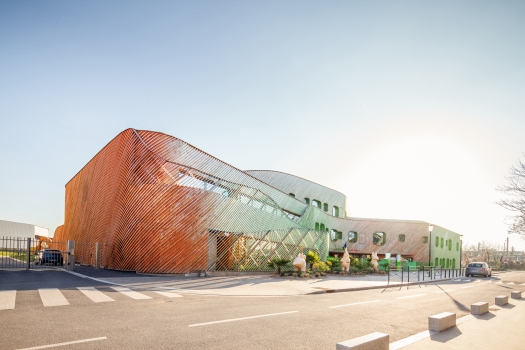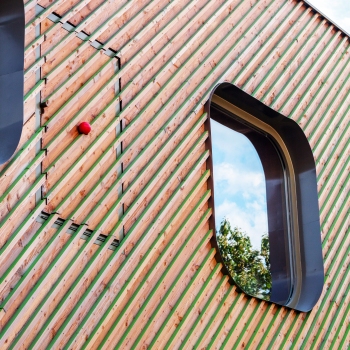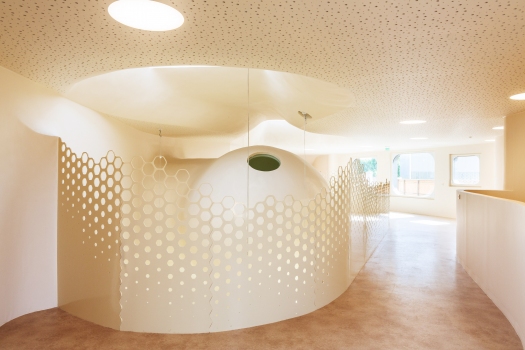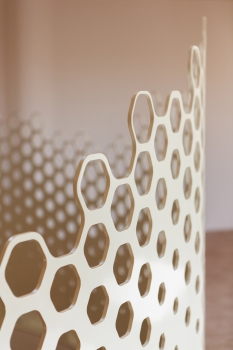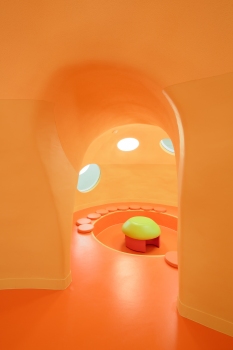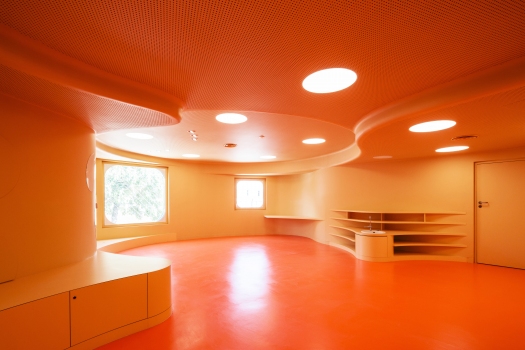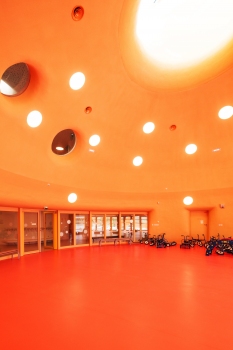General Information
| Completion: | August 2015 |
|---|---|
| Status: | in use |
Project Type
| Function / usage: |
Primary school Kindergarten |
|---|
Location
| Location: |
Saint-Denis, Seine-Saint-Denis (93), Ile-de-France, France |
|---|---|
| Address: | 1 bis chemin des petits cailloux |
| Coordinates: | 48° 54' 34.21" N 2° 21' 20.43" E |
Technical Information
Dimensions
| gross floor area | 4 800 m² |
Cost
| cost of construction | Euro 12 000 000 |
Nursery and Primary School in Saint-Denis, France
The school « Niki de Saint-Phalle – Petits Cailloux » is composed of a nursery with eight classrooms, a primary school with ten classrooms, a school cafeteria and a recreation center. The building has three levels and a basement which contains a service room. For an equal allocation of the access and connections to the different units, the construction site has been divided into six parts: three outdoor (entrance, nursery playground, and primary playground) and three indoor (nursery school, primary school and school cafeteria with recreation center). This division results in a clover-shaped building that offers, in addition to convergent and economic corridors, a very good connection between the inside and the outside (many views, points of access and a very intuitive orientation).
Architectural Concept
Inside the building, considering the differences in teaching concepts in the nursery school and the primary school, two spatial designs were developed as different as the right brain can be from the left. Similarly to a human brain, where the hemispheres are symmetrical, but not identical and distinct in their vital functions, this building is symmetrical as well only in appearance. The fact of entering the school in diapers and leaving knowing how to read, and with knowledge in arithmetic, science, and geography, perfectly illustrates how huge the gap is between these two aspects of schooling.
The nursery classrooms are systematically composed of three circular spaces with three different diameters and ceiling heights. The primary classrooms are square shaped with one side made entirely of glass. The pore spaces between the circles are used for storage, providing more surface area inside the classrooms.
The multi-purpose nursery room is circular, covered by a semi-spherical ceiling, while the primary room is square with a pyramidal ceiling. These two huge spaces open onto the playgrounds and benefit from large overhead lighting. Also by opening onto the corridors, they contribute to the natural indoor lighting and the ease of orientation in the building with the transparencies between the inside and the outside.
Organization and Perambulation
One of the architect's priorities was about getting around and ease of orientation in the space. From the entrance, the clover shape structure of the hall enables the visitor to see straight through to the two playgrounds. Once in the hall, three accesses converge from the nursery school on the right, the primary school on the left and the recreation center in the front by the large stairs surrounding the elevator. The hall pierces the entire height of the building and is permeated by overhead lighting. Two spheres in suspension animate this great void: each sphere is a reading space belonging to the libraries of the nursery school and the primary school, respectively. Paul le Quernec wanted to make a statement by positioning "the book" at the epicenter: the suspension in the void suggesting the elevation by knowledge.
Outer Shell
Considering the building’s proportions, the treatment of its façade was a challenge. To avoid monotony and a fixed facade, the architect opted for a wooden cladding system with battens that changes as the visitor goes around the building: the inferior facet of the battens is painted orange, the superior is painted apple green and the front facets are left rough. This way, the frontal view of the facade is completely neutral and its neutrality recedes as the look becomes oblique. The main facade looks green when entering the building and orange when leaving it. This effect is an initiation to the optic illusions which have great educational value for training the mind. Every choice made on this project has been done considering the impact on children’s psychomotor development.
Participants
Relevant Web Sites
There currently are no relevant websites listed.
- About this
data sheet - Structure-ID
20067683 - Published on:
09/09/2015 - Last updated on:
26/02/2019

